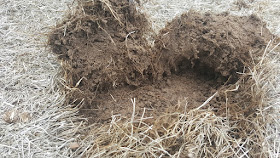 It’s been a dry fall and early winter throughout most of
Colorado – in spite of the recent snow (that’s rapidly disappearing as I write
this today). Little precipitation, combined with windy, sunny, and warm days,
is a pretty good recipe for some winter turf injury (aka “winterkill”). Throw
in some alternating extreme cold with the warm days and things get potentially
worse for turf, trees, and shrubs in our landscapes. But not all “winterkill”
is the same when it comes to turf. Here are some examples from the spring of
2017 (these were all in April/May) to illustrate that point.
It’s been a dry fall and early winter throughout most of
Colorado – in spite of the recent snow (that’s rapidly disappearing as I write
this today). Little precipitation, combined with windy, sunny, and warm days,
is a pretty good recipe for some winter turf injury (aka “winterkill”). Throw
in some alternating extreme cold with the warm days and things get potentially
worse for turf, trees, and shrubs in our landscapes. But not all “winterkill”
is the same when it comes to turf. Here are some examples from the spring of
2017 (these were all in April/May) to illustrate that point.
Winter injury from drought – enhanced by VERY thick thatch
in this bluegrass lawn. Note that the green turf is where water was supplied by
a gutter downspout, runoff from the driveway (plus the concrete acts as a “mulch”
for turf growing alongside it), and runoff from the neighbor’s gravel-covered
plastic.
This lawn had been sodded in early 2016 and was perfectly
green and healthy going into the winter of
 |
| Dead area is where home construction had been "staged", resulting in extreme soil compaction before sodding. |
 |
| Sod had not rooted into the compacted soil, which lead to winter kill in spring 2017. |
 |
| Winter mite injury |
This lawn suffered from turfgrass mite feeding in the late
winter and early spring. Mite feeding and reproduction is favored by dry
conditions. Drought-stressed turf is often killed by mite feeding in the spring
if numbers are high enough and no snowcover or spring rains occur – and if winter
watering isn’t performed at least a few times during the winter.
The common thread here? Water! Turf, trees, shrubs, and
other landscape plants may not be growing and thus USING much water during the
winter. But when it’s dry, windy, sunny, and humidity is low, our landscape
plants are LOSING water. When we don’t receive enough snow to provide periods
of snow cover during the winter, and plants aren’t mulched (like turf!), are
young and not fully established, or have poorly developed root systems, winter
watering can be essential for preventing winter injury or death.
When weather allows (above freezing for a day or two), run a
hose and sprinkler out to the drier parts of your landscape (especially south-
and west-facing parts of your landscape), to new sod, trees, and shrubs, and to
areas where you have experienced winter injury in the past (perhaps from turf
mites). Apply enough water to moisten the crowns of the turf plants and to get
some water into the root zone of new trees and shrubs. The goal isn’t deep
watering, but rather to prevent desiccation of crowns and young root systems.


No comments:
Post a Comment